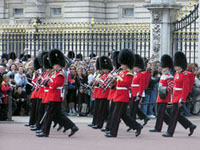Errors
Buckingham Palace
Mistaking Awesome for Ancient
They're changing the guard at Buckingham Palace . . .
And the tourists are impressed. They imagine that this rich and quaint pageantry is coming at them straight out of the Middle Ages, complete with its unworldly hats. They expect to rub elbows with Richard the Lion Heart as they climb back on the tour bus. They expect the red-haired barmaid back at the hotel to be Mary Stuart.
In these expectations they are deluded. Eric Hobsbawm's introduction to Hobsbawm and Ranger, The Invention of Tradition (Cambridge 1983), states the basic caution:
Nothing appears more ancient, and linked to an immemorial past, than the pageantry which surrounds the British monarchy in its public ceremonial manifestations. Yet, as a chapter in this book establishes, in its modern form it is the product of the late nineteenth and twentieth centuries. "Traditions" which appear or claim to be old are often quite recent in origin, and sometimes invented.We might add that the whole point of ritual is to seem ancient. To impress citizens with the antiquity of their society. To impress believers with the timelessness of their creed. To reach back to the divine beginnings of things. Experts in ritual know better. In Gregorian chant, for instance, the pieces most commonly sung are not from the earlier, modal part of the repertoire, but from the later part: the part influenced by Renaissance theories of tonality. The effect to us, in listening, is that of a disembodied voice coming from the world's beginning. That effect is entirely meretricious.
Offered a choice of tunes (as we are, in the Liber Usualis, between ancient and modern Gregorian chant), the modern ear typically prefers the modern. It prefers what is nearer to its own time. The modern mind demands antiquity, but it wants an antiquity which is agreeable to its own taste. The adjustment of past practice to modern taste operates continually, as a tradition extends and renews itself. The process of replacement, in ritual and other traditions, is normal and natural. We expect it. The historian, observing all this, needs to be alert not to mistake the end product of the process for its beginning.
As for the grand plaza in which the Changing of the British Guard so conspicuously takes place, even the British Tourist Authority will freely admit that it is not a relic of high mediaeval times. It was constructed in 1911.
15 June 2004 / Contact The Project / Exit to Outline Index Page
